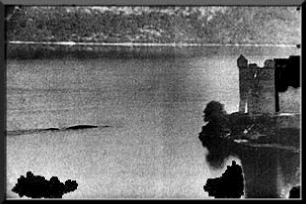Editorial On “Death At Loch Ness”
Posted by: Loren Coleman on January 10th, 2010

Time For Some Level-Headed Thinking On “Death at Loch Ness”
An Editorial
By Loren Coleman
In recent months, you have read here of Robert Rines’ media statements regarding the possible extinction of the Loch Ness Monsters, which got drummed up in the press, literally, as the “death of Nessie,” both in the UK newspapers and on an episode of “MonsterQuest.” That was recently picked up by Loch Ness Monster Fan Club president Gary Campbell in his yearend summary, which we published here at Cryptomundo. His statements are now being circulated around the United Kingdom over the weekend.
Unfortunately, it looks like the UK media has taken Campbelll’s overview and promoted it to headline status. The Scottish Daily Record came out with a story entitled “The end of Nessie: Researchers fear Loch Ness monster may be dead.” The story has turned up elsewhere, as well.
The Daily Record noted, in dramatic fashion:
Nessie fans fear their favourite monster may be dead, it emerged yesterday. There was only one decent sighting in Loch Ness last year and a recent documentary explored the possibility that the monster might be sleeping with the fishes. Now Nessie watchers have warned that there are “reasons to be fearful.”
Official Loch Ness Monster Fan Club president Gary Campbell said sightings were becoming increasingly rare….
A 2009 episode of TV documentary series Monster Quest, titled “Death At Loch Ness,” examined the theory that Nessie’s carcass is lying at the bottom of the loch.
But Gary said: “If people start to believe this, it might affect tourist numbers.
Now this part of the story is being picked up anew throughout the blogosphere.
It is time for a definitive straight comment about this “death at Loch Ness” (read “extinction of Nessies”) business.
I shall be short and sweet, and to the point. The underlying reason behind all the talk about death came from Robert Rines, and it was a direct psychological and personal reflection of his own sense of the end of his own life and the end of his search for the Loch Ness Monsters. Mortality, naturally, influenced his view.

Robert Rines at Loch Ness, in his last television appearance before his death, during “MonsterQuest.”
Rines had done it all. Put his money, his mind, and his minutes and months into the search for the ultimate proof of the Loch Ness Monsters. Of course, at the end of his life, he proclaimed statements on the “death of Loch Ness.”
What is so clearly evident is that Rines’ statements were interwoven with his own sense of the end for himself. It is unfortunate that this reality for the origins of the “death of Loch Ness” comments have not been viewed in their actual context, and that they are now seriously being considered by thoughtful people involved in the Loch Ness Monsters’ quest.
I am not certain of the actual reality of the Loch Ness Monsters, any more than the next open-minded, skeptically-inclined cryptozoologist. But I see no less or more evidence for them during the 21st century than was available during the 20th century. Sightings at Loch Ness of the watery cryptids have routinely had good years and bad years.
Robert Rines, whom I met at Loch Ness, corresponded with before and after, and greatly admired, is no longer with us and is missed. He died November 1, 2009, at the age of 87. His sense of his own end, as projected psychologically from himself onto the Loch Ness Monsters, should not slow down the search for valid proof of whatever has been encountered in that Scottish lake for centuries.
Of all the people linked to Loch Ness, surely it would be Bob Rines who would say, in the final analysis, Onward! Continue the search at Loch Ness.
About Loren Coleman
Loren Coleman is one of the world’s leading cryptozoologists, some say “the” leading living cryptozoologist. Certainly, he is acknowledged as the current living American researcher and writer who has most popularized cryptozoology in the late 20th and early 21st centuries.
Starting his fieldwork and investigations in 1960, after traveling and trekking extensively in pursuit of cryptozoological mysteries, Coleman began writing to share his experiences in 1969. An honorary member of Ivan T. Sanderson’s Society for the Investigation of the Unexplained in the 1970s, Coleman has been bestowed with similar honorary memberships of the North Idaho College Cryptozoology Club in 1983, and in subsequent years, that of the British Columbia Scientific Cryptozoology Club, CryptoSafari International, and other international organizations. He was also a Life Member and Benefactor of the International Society of Cryptozoology (now-defunct).
Loren Coleman’s daily blog, as a member of the Cryptomundo Team, served as an ongoing avenue of communication for the ever-growing body of cryptozoo news from 2005 through 2013. He returned as an infrequent contributor beginning Halloween week of 2015.
Coleman is the founder in 2003, and current director of the International Cryptozoology Museum in Portland, Maine.










I never liked the Nessie extinction theory. It seems to me that if sightings are still occurring that obviously some are still in the lake. But just because there is a period of no sightings doesn’t mean that we should rush to the assumption that a cryptid no longer lives as a species..I think it just takes patience and diligence when we are in a dry spell for certain cryptid sightings.
There is no reason to take any pronouncements of the self-styled “Official” fan club any more seriously than anything else on that website and I was surprised they were given the oxygen of publicity here in the first place.
As long ago as August 2001 the UK’s Guardian newspaper website carried a story entitled Is Nessie Dead? in which Dr Rines is quoted as saying “You have the hydro plant for one thing and all the forestry plantings which unfortunately were done here in such a way that streams of lime acid poured down into the loch. The environmental change hasn’t been going Nessie’s way.”
Anyone with high-school chemistry knowledge might query this alchemical “lime acid” and anyone with local knowledge will report the existence of a Victorian “hydro plant” at Foyers predating Nessie herself, but it is entirely understandable that someone failing to find a species called Nessie might begin to look for an explanation consistent with their original beliefs, rather than go through the anguish of changing them.
Nessie may be the most famous Scottish lake monster(s), but it’s hardly the only one.
Does anyone know about recent sightings of Morag over at lake Morar?
Great editorial, Loren. I agree and believe that, along with thoughts of his own mortality in the waning days, the “Death at Loch Ness” theory was a psychological mechanism for Dr. Rines to take the creature’s(or creatures’) existence with him to the grave. With all the photographic evidence Dr. Rines amassed over the years, it still wasn’t enough to merit irrefutable proof of the monster’s existence, so the theory becomes a way for a man who sincerely believed in the monster to satisfy his own beliefs and be at peace with his many years of work on the subject.
I’m a believer in lots of concepts…However I find this idea to be a slap in the face to even thinking Nessies could be real. Loren is right to be blunt and think there’s a connection with Rines’s age and overall health. The way I see is people like us who think it’s possible for Nessies to be real or hope so, are weirdos to most and not taken very seriously. So does it help that after all this time he has given us no body or solid evidence? I mean…I found it cool what they picked up on sonar images in their time exploring, but the damned truth is in the end it doesn’t mean anything to the nay sayers or the world if you don’t give us a body or that body on film.
What has happened here is we went from Nessies might be real to them being dead, but we don’t have any proof that Nessies might be dead. This is how people get called hoaxers. I’m sorry but that looks like it’s the sad truth here.
If there extinct, then ramp up the search for remains if the living ones have ceased to be.
Even if this loch is now “Nessieless”, it doesn’t mean they would be extinct. This is not the only body of water that contains a possible cryptid. It is quite a conundrum for people who need the Loch Ness Monster to “exist” for tourism purposes… of course they are going to hope/believe it is still there, so are their opinions steeped in honesty?
THANK YOU LOREN!
I was tired of that bunk when it first danced across the headlines…
Like you said, there’s still reports coming in…the media is a manipulative, greedy cuss–they drum up headlines about monsters to get readers, and are just as quick to kill them off to keep eyes on their paper.
I’d prefer: Nessie hoards golfballs at bottom of loch…does she think their her eggs, is she eating them,…film at 11.
A very interesting assessment. Until sightings increase again though, Mr.Rines belief will carry a little more weight with this reader. Got to go with the evidence, eh? (or what passes as such)
Let’s not be too quick to discount Mr. Rine’s scientific acumen, even during the period when he was facing impending death. Save this theory for when Nessie sightings have spiked; fingers crossed!